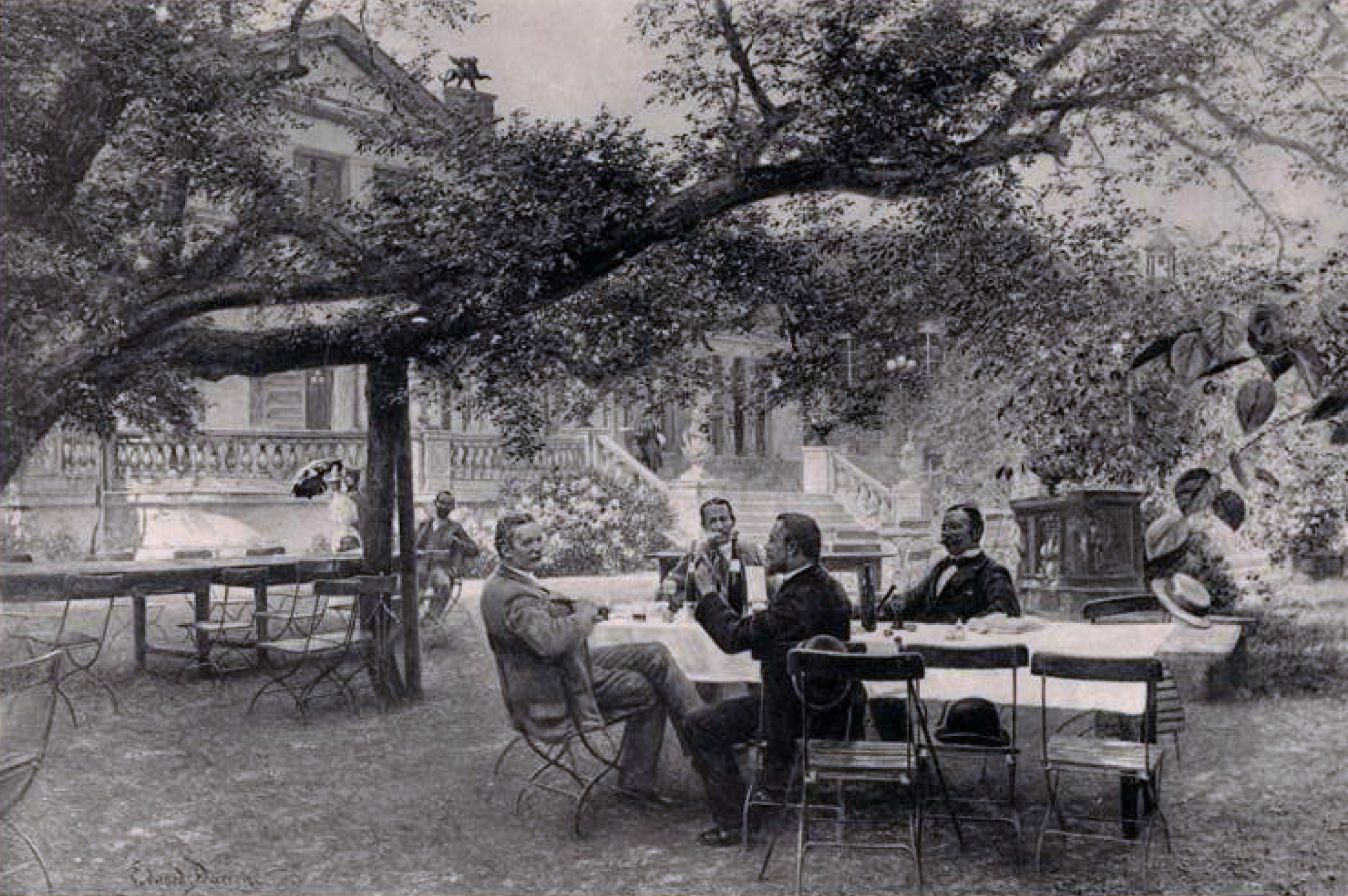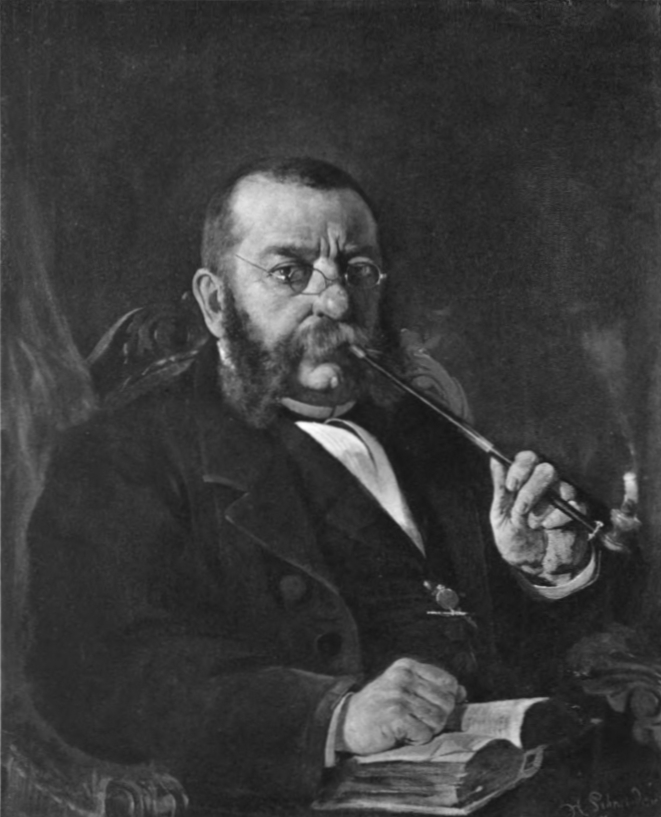|
Eduard Daelen
Eduard Adolf Daelen (18 March 1848 – 9 May 1923) was a German painter and writer. For some of his writings he used the pseudonyms Ursus teutonicus, Angelo Dämon, Edu Daelen-Bachem and Michel Bär. He became known above all for the first biography of Wilhelm Busch, which he wrote in 1886. Life Born in Hörde, Daelen was the son of a senior engineer. Although he much preferred to study art, he was first forced to study mechanical engineering. To this end, he was enrolled at the trade school in Barmen from 1863 to 1865 and at the trade academy in Berlin from 1867 to 1868. It was not until the autumn of 1868 that he entered the elementary class with Andreas Müller at the Kunstakademie Düsseldorf, but left again in the autumn of 1869 "because he could not yet get a place in the antique hall". He therefore went first to the Berlin and until 1875 to the Munich Academy of Arts, where Otto Seitz and Wilhelm von Diez were his teachers. After a short stay in Rome, he settled in Düs ... [...More Info...] [...Related Items...] OR: [Wikipedia] [Google] [Baidu] |
Der Verfasser Des Festspiels "Hollands Blütezeit" Maler Eduard Daelen Als Rembrandt, 1912
Der or DER may refer to: Places * Darkənd, Azerbaijan * Dearborn (Amtrak station) (station code), in Michigan, US * Der (Sumer), an ancient city located in modern-day Iraq * d'Entrecasteaux Ridge, an oceanic ridge in the south-west Pacific Ocean Science and technology * Derivative chromosome, a structurally rearranged chromosome * Distinguished Encoding Rules, a method for encoding a data object, including public key infrastructure certificates and keys * Distributed Energy Resources * ∂, the partial derivative symbol *Deep energy retrofit, an energy conservation measure Organizations * Digital Education Revolution, former Australian Government-funded educational reform program * DER rental (Domestic Electric Rentals Ltd), a UK television rentals company * Documentary Educational Resources, a non-profit film producer and distributor Other uses *Defence (Emergency) Regulations, legal regulations promulgated by the British in Mandatory Palestine in 1945 *Department of Env ... [...More Info...] [...Related Items...] OR: [Wikipedia] [Google] [Baidu] |
Karl Müller (painter)
Karl Müller, also Carl Müller ( 29 October 1818 – 15 August 1893) was a German late Nazarene painter of the Düsseldorf school of painting. Life Born in Darmstadt, Müller was the son of the court painter and gallery director (1784–1835). Like his older brothers Andreas and Constantin, he attended the Düsseldorf Art Academy after training with his father, where he was enrolled from 1835. After initial lessons with Karl Ferdinand Sohn, he was instructed there from 1836 by Friedrich Wilhelm von Schadow. He was listed as his ' in 1849/1850. In 1839 he undertook a trip to Italy with Franz Ittenbach, accompanied by Schadow, to study fresco painting of the Quattrocento. From 1840 to 1842 he lived in Rome, where he met, among others, Peter von Cornelius and Friedrich Overbeck. From there, he undertook study trips to Tuscany and Umbria. In spring 1843, he studied the monumental Cornelius frescoes in the Munich Ludwigskirche. From 1844 to 1850, he worked together with Ernst D ... [...More Info...] [...Related Items...] OR: [Wikipedia] [Google] [Baidu] |
Mittag Im Malkasten
Mittag may refer to: * Anja Mittag (born 1985), German international footballer * Gösta Mittag-Leffler Magnus Gustaf "Gösta" Mittag-Leffler (16 March 1846 – 7 July 1927) was a Swedish mathematician. His mathematical contributions are connected chiefly with the theory of functions, which today is called complex analysis. Biography Mittag-Leffle ... (1846–1927), Swedish mathematician * Günter Mittag (1926–1994), central figure in the German planned economy * Susanne Mittag (born 1958), German politician {{surname, Mittag Surnames from nicknames German-language surnames Surnames of Jewish origin ... [...More Info...] [...Related Items...] OR: [Wikipedia] [Google] [Baidu] |
Kaspar Braun
Kaspar Braun (13 August 1807 – 29 October 1877) was a German wood engraver. Biography He was born at Aschaffenburg, first studied painting in the Munich Academy, and then turned his attention to wood engraving, in which he received instruction from Brevières in Paris and Dessauer in Munich, and in this branch of art he made his career. In conjunction with Dessauer, he established a graphic art institute in Munich in 1839. He became associated with Friedrich Schneider in 1843, and established the humorous publication ''Fliegende Blätter''. Works Among the numerous works to which he contributed engravings are the following: * ''Das Nibelungenlied'', after the drawings of Schnorr and Neureuther * ''Volkskalender'', with illustrations after Kaulbach Kaulbach or von Kaulbach is a German surname. Notable people with the surname include: * Bruno Franz Kaulbach (1880–1963), Austrian Lawyer *Charles Edwin Kaulbach (1834–1907), a Canadian merchant, ship owner and politica ... [...More Info...] [...Related Items...] OR: [Wikipedia] [Google] [Baidu] |
Berndt W
Berndt is a surname and can refer to: *Arthur Berndt * Bruce C. Berndt * Catherine Berndt * Doug Berndt * Jerry Berndt * John Berndt * Jule Berndt, American Lutheran clergyman and politician * Helmut Berndt * Marianne Berndt * Ronald Berndt *Sonja Berndt, American pharmacologist and cancer epidemiologist * Walter Berndt *William Berndt, American politician Berndt can also be a given name: *Berndt Ekholm *Berndt Sköldestig Berndt Sköldestig, 1944–2006, is a Swedish social democratic politician, member of the Riksdag The Riksdag (, ; also sv, riksdagen or ''Sveriges riksdag'' ) is the legislature and the supreme decision-making body of Sweden. Since 1971, ... {{given name, type=both Surnames from given names ... [...More Info...] [...Related Items...] OR: [Wikipedia] [Google] [Baidu] |
Frankfurter Zeitung
The ''Frankfurter Zeitung'' () was a German-language newspaper that appeared from 1856 to 1943. It emerged from a market letter that was published in Frankfurt. In Nazi Germany, it was considered the only mass publication not completely controlled by the Propagandaministerium under Joseph Goebbels. History In 1856, German writer and politician Leopold Sonnemann purchased a struggling market publication in Germany; the ''Frankfurter Geschäftsbericht'' (also known as ''Frankfurter Handelszeitung''). Sonnemann changed its name to ''Neue Frankfurter Zeitung'' (later simply ''Frankfurter Zeitung'') and assumed the duties of publisher, editor, and contributing writer. The new title incorporated political news and commentary, and by the time of the foundation of the German Empire in 1871, the ''Frankfurter Zeitung'' had become an important mouthpiece of the liberal bourgeois extra-parliamentary opposition. It advocated peace in Europe before 1914 and during World War I. In Constanti ... [...More Info...] [...Related Items...] OR: [Wikipedia] [Google] [Baidu] |
Friedrich Theodor Vischer
Friedrich Theodor Vischer (; 30 June 180714 September 1887) was a German novelist, poet, playwright, and writer on the philosophy of art. Today, he is mainly remembered as the author of the novel '' Auch Einer'', in which he developed the concept of (the spite of objects), a comic theory that inanimate objects conspire against humans. Biography Born at Ludwigsburg as the son of a clergyman, Vischer was educated at Tübinger Stift, and began life in his father's profession. He became in aesthetics and German literature at his old university in 1835, was advanced to extraordinary professor two years later, and was appointed to full professor in 1844. Due to his outspoken inaugural address he was suspended for two years by the Württemberg government. In this enforced leisure he wrote the first two volumes of his ''Aesthetik, oder Wissenschaft des Schönen'' (1846), the fourth and last volume of which did not appear till 1857. Vischer threw himself heartily into the great German po ... [...More Info...] [...Related Items...] OR: [Wikipedia] [Google] [Baidu] |
Gottfried Wilhelm Leibniz
Gottfried Wilhelm (von) Leibniz . ( – 14 November 1716) was a German polymath active as a mathematician, philosopher, scientist and diplomat. He is one of the most prominent figures in both the history of philosophy and the history of mathematics. He wrote works on philosophy, theology, ethics, politics, law, history and philology. Leibniz also made major contributions to physics and technology, and anticipated notions that surfaced much later in probability theory, biology, medicine, geology, psychology, linguistics and computer science. In addition, he contributed to the field of library science: while serving as overseer of the Wolfenbüttel library in Germany, he devised a cataloging system that would have served as a guide for many of Europe's largest libraries. Leibniz's contributions to this vast array of subjects were scattered in various learned journals, in tens of thousands of letters and in unpublished manuscripts. He wrote in several languages, primarily in Latin, ... [...More Info...] [...Related Items...] OR: [Wikipedia] [Google] [Baidu] |
Peter Paul Rubens
Sir Peter Paul Rubens (; ; 28 June 1577 – 30 May 1640) was a Flemish artist and diplomat from the Duchy of Brabant in the Southern Netherlands (modern-day Belgium). He is considered the most influential artist of the Flemish Baroque tradition. Rubens's highly charged compositions reference erudite aspects of classical and Christian history. His unique and immensely popular Baroque style emphasized movement, colour, and sensuality, which followed the immediate, dramatic artistic style promoted in the Counter-Reformation. Rubens was a painter producing altarpieces, portraits, landscapes, and history paintings of mythological and allegorical subjects. He was also a prolific designer of cartoons for the Flemish tapestry workshops and of frontispieces for the publishers in Antwerp. In addition to running a large workshop in Antwerp that produced paintings popular with nobility and art collectors throughout Europe, Rubens was a classically educated humanist scholar and diploma ... [...More Info...] [...Related Items...] OR: [Wikipedia] [Google] [Baidu] |
Leonardo Da Vinci
Leonardo di ser Piero da Vinci (15 April 14522 May 1519) was an Italian polymath of the High Renaissance who was active as a painter, Drawing, draughtsman, engineer, scientist, theorist, sculptor, and architect. While his fame initially rested on his achievements as a painter, he also became known for #Journals and notes, his notebooks, in which he made drawings and notes on a variety of subjects, including anatomy, astronomy, botany, cartography, painting, and paleontology. Leonardo is widely regarded to have been a genius who epitomized the Renaissance humanism, Renaissance humanist ideal, and his List of works by Leonardo da Vinci, collective works comprise a contribution to later generations of artists matched only by that of his younger contemporary, Michelangelo. Born Legitimacy (family law), out of wedlock to a successful Civil law notary, notary and a lower-class woman in, or near, Vinci, Tuscany, Vinci, he was educated in Florence by the Italian painter and sculptor ... [...More Info...] [...Related Items...] OR: [Wikipedia] [Google] [Baidu] |






.jpg)